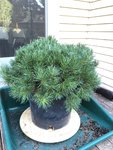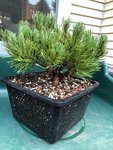Hello Bonsai Nuts,
I'm new to this forum and I am relatively new to bonsai. I hope this is the right thread to post or I should start a new post (please let me know if I shouldn't do it here). I have a Japanese Maple, Trident Maple and a Chinese elm that I bought online over the last 10 years. I never really dedicated fully to the hobby. I'm entering semi retirement mode and I have more time on my hand. I have been reading the forum threads and stumbled into the Mugo Pine train. I really want to build my own bonsai from nursery materials and the mugo is a perfect choice for mainly 2 reasons. 1) Use this Mugo Pine journey to learn (pruning, repotting, candling, etc.) 2) Extensive resources and help here I can lean on. I'm ready to enter this Mugo journey.
I live in eastern Pennsylvania, zone 6b. Over the past few days, I went to my local big box stores (Home depot and Lowes). I found these 2 Pines (photos). The bigger one I bought it from Lowes (feels like a 2 to 2.5 inch trunk diameter) and the smaller one at Home Depot (~1.5 inch trunk). I got 2 to increase my chance of success. I read through this
tutorial thread and focusing on the TREATMENT OF NEW NURSERY MUGOS section.
Here are my next steps for these guys:
1) Remove dead branches and debris (done)
2) Remove them from nursery pots and lightly clean out the top
3) Saw off 50% of the root ball, bottom half and remove 25% of circling roots if any
4) Remove 1/2 of the foliage. This is where I'm not sure what I can get rid of, I want to remove a lot of the lower branches and thin the upper part so light can shine through.
5) Prepare a soil mixture of 1 part akadama, 1 part pumice, 1 part pine bark, 1 part small lava rock. (I'm thinking of reusing some of the removed soil into the mixture)
6) I got a couple of water plant basket (10 x 10 square) as the new home for these trees.
7) Water them thoroughly; repeat when the first inch or so of the soil is dry (I'm planning to use a moisture meter)
8) Place them in shady area for 2 weeks.
What are the next steps?
Do I just let them be until next July 2021 before doing any pruning or wiring? I like to do some light wiring and pruning (maybe end of August) and leave them be.
Please chime in if I am missing anything.
Thank you.
View attachment 317392View attachment 317393View attachment 317394View attachment 317392View attachment 317393











